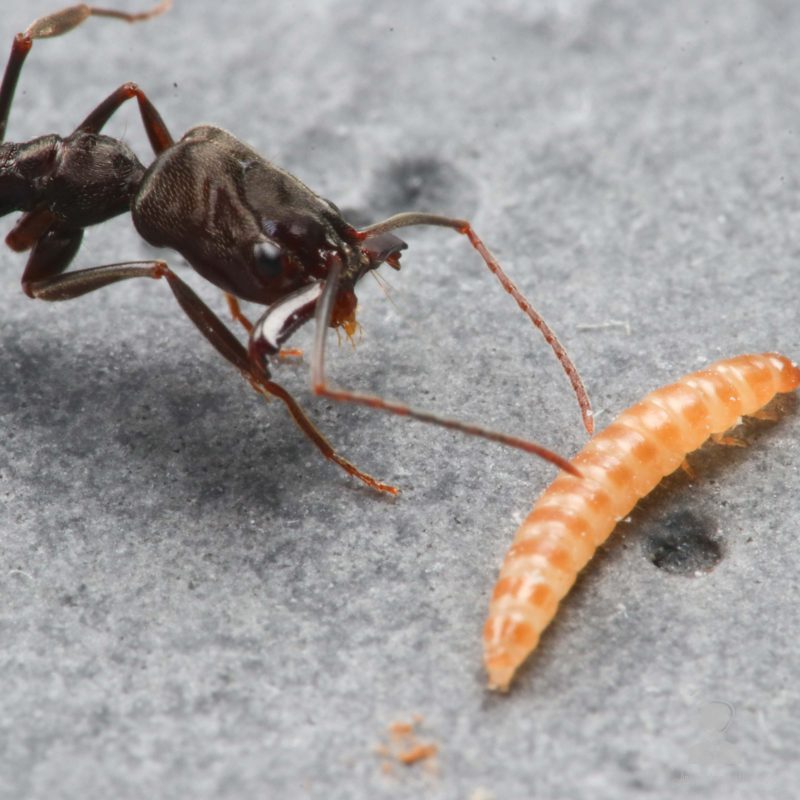文章目錄
懶人包
飼養螞蟻會需要:蟻巢、飼料、餵食區
新手推薦螞蟻:巨山蟻 ( 如希氏巨山蟻 )
螞蟻食物:專用飼料、糖水、麵包蟲、蟑螂
螞蟻餵食頻率:1 周 1 次
螞蟻加水頻率:1 月 1次
飼養環境:室溫,不超過 32 度
特別注意:不曬太陽、不殺蟲劑、不過多震動打擾

螞蟻哪裡有趣?
螞蟻非常聰明、有組織,在蟻巢內,每隻螞蟻都有不同的工作,例如清潔、打掃、覓食、攻擊、產卵、照顧同伴等等。
想像一下,看著蟻后,從孤身一人,慢慢產卵、扶養孩子,直至數年後,成為一個擁有成百、上千人口的強盛王國,巢穴內,如同人類社會一般,井然有序的運行著。
這個世界,之所以能運轉起來,都是因你的賜予。養螞蟻最令人津津樂道的,就是這個過程,你將會收穫滿滿成就感。

準備工作
養螞蟻需要怎樣的環境?
養螞蟻需要準備什麼?
首先,你需要確保合適的飼養環境,這很簡單,通常只要室溫飼養,避免養在西曬房、頂樓加蓋的室內,同時避免出現殺蟲劑、水煙、蚊香等毒物。
也可讓螞蟻跟你一起住,你熱了,就開冷氣,螞蟻一起吹冷氣,一舉兩得,具體而言,飼養螞蟻的溫度在14~32度之間,26~28度最佳。
接著,準備螞蟻、蟻巢、飼料等飼養用品,就可以著手培養自己的王國囉。
如何飼養螞蟻?
很簡單,但仍需細心注意,螞蟻是一種很容易飼養的寵物,大方向是,一周餵食1~2次、一個月補充1次水份即可,後續端看螞蟻人口數量,決定是否要幫其擴充蟻巢。
一般的初始小型蟻巢,大概要花費一年左右才有辦法住滿,其實並不會很頻繁更換蟻巢。

螞蟻的種類和特點
台灣有300多種螞蟻,每種螞蟻都有獨特的行為、習性,而主流飼養的種類,大概是10種。
絕大多數的飼主,在首次接觸螞蟻飼養,會先從「巨山蟻」屬的螞蟻入門,因為巨山蟻體型大、耐受性好、成長穩定、容易觀察,飼養的成功率最高。
尤其巨山蟻的腹部,可以貯存很多的食物,因此在餵食後,可以看到蟻巢內的工蟻們,每隻的屁屁都是撐滿滿的,裡面是剛剛餵食的飼料,非常有趣。
螞蟻的習性和行為
螞蟻會建造、拆除、覓食、取水、狩獵、搬家、餵食、育幼、生產、交配、洗澡、清潔、丟垃圾、搜尋食物、保護自己的領地和族群,並且會分工合作。
螞蟻能夠透過化學訊號,相互溝通,讓每一個螞蟻都能夠扮演自己的角色。

螞蟻的生命週期
螞蟻的生命週期,可以分為四個階段:卵、幼蟲、蛹和成蟻。
蟻后會生下卵,1~2個月後,逐漸孵化至成蟲。蟻后通常2~4周左右產一批卵,一批卵大約6~12顆,因此其實螞蟻成長的速度,沒有一般人想像的那麼快,以巨山蟻來說,大概飼養一年以上,才有機會達到100隻工蟻以上。
螞蟻的社會體系
螞蟻是一種非常有組織、有社會性的昆蟲,螞蟻總共有:蟻后、雄蟻、兵蟻、工蟻這四種階級,每個階級的外觀、壽命、數量、工作內容都不相同。
以巨山蟻為例,一個飼養了4年的人口成熟的蟻巢內,會有1隻蟻后、數十~數百隻兵蟻、上千隻工蟻,同時,雄蟻只會在婚飛季節少量且短暫出現,並不會常駐在蟻巢內。

如何觀察螞蟻?
我們可透過一側透明的;特殊設計的蟻巢,來觀察蟻巢內的活動,以及在螞蟻的餵食區放置食物,觀察螞蟻的覓食與合作,更有飼主會為螞蟻接上錯綜複雜的連接管道,觀察螞蟻的行軍、搬家。
養螞蟻的注意事項
首先,要避免讓螞蟻受到外界的干擾,例如觸碰蟻巢,或給螞蟻吃過多的食物。其次,要定期清理餵食區和更換食物,避免蟻巢變髒,或者螞蟻吃到腐爛的食物。
最後,要確保飼養環境中不會出現任何毒物,例如殺蟲劑、蚊香等等。
養螞蟻的樂趣
我認為養螞蟻有兩個最主要的樂趣
1、滿足好奇心
觀察螞蟻,是一件非常有趣的事情。研究顯示,能夠被一般人,在野外看到的螞蟻,其行為只占總活動量的30%,例如覓食、狩獵、搬運等,而有高達70%的行為,只發生在蟻巢內。
蟻巢內的互動,更像是一個人類社會的縮影,例如產卵、餵食、清潔、維護環境,甚至還有更多,連我們或是螞蟻學家,都尚未發現的行為,這些發現,唯有親自飼養,才有機會觀察到。
2、獲得成就感
當你花費數年,看著一隻蟻后開始,慢慢地產卵;扶養,出現了第一批工蟻、見證了生命的誕生,最終達到成百上千隻螞蟻。
其中,每個個體,都像是人一樣,有自己的工作、角色,還會與其他人互動,儼然就是一個完整的人類社會,這個龐大的螞蟻王國,是由你一個人照顧、培養出來的,你就是這個國家的天神,你掌管著一切!

結論
螞蟻是一種神奇的昆蟲,它們擁有非常豐富的生態,和社會行為。養螞蟻不僅可以讓我們了解螞蟻的生活,還可以讓我們感受到生命的奧妙。希望通過這篇「第一次養螞蟻全攻略」,能夠讓更多的人了解養螞蟻的樂趣和方法,打開美妙小世界的鑰匙。
FAQs
我可以從哪裡獲得螞蟻?
可以在婚飛季節於野外捕捉,或是與商家購買。
養螞蟻一定要有蟻后嗎?
只有蟻后才會產卵,群落才能延續、發展下去,所以養螞蟻一定要有蟻后。
螞蟻可以養多久?
這取決於蟻后的壽命,蟻后在,蟻群在,蟻后亡,蟻群歿,好在,蟻后的壽命通常有10~20年左右。
養螞蟻會很花時間嗎?
養螞蟻完全不花時間,只需要一周餵食1~2次,一個月補充1次水份即可。
養螞蟻會很貴嗎?
養螞蟻可以很貴,也可以很便宜,端看飼養方法,不過平均而言,通常台幣1000~2000元左右就可以擁有一整套完善的養蟻用品了(包含螞蟻)
